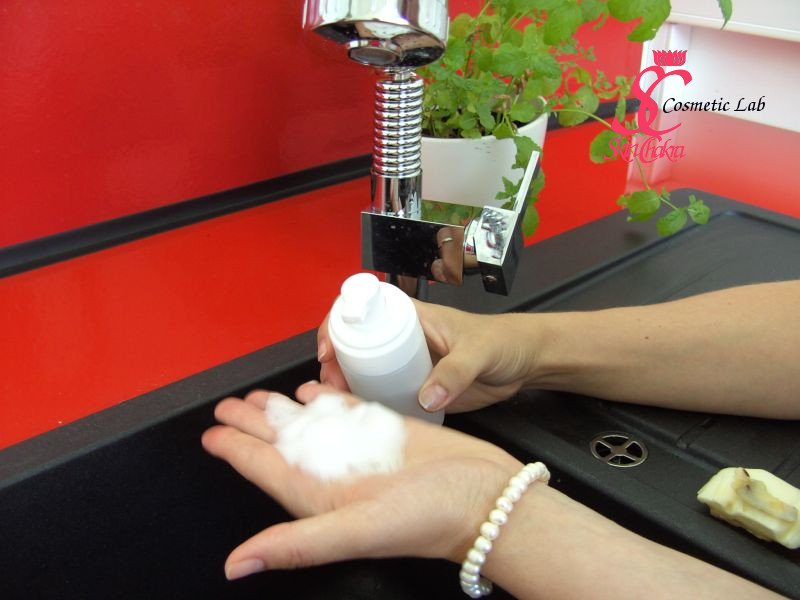Mittwoch, 6. August 2014
Why We Love Foam
Despite all our common passion for soap making there are at least 100 reasons why you should know how-to and should prepare at least one foam in your professional life. I'm not going to count all reasons but having more than 15 years experience in the industry, let me have a brief comparison between a CP or HP soap (liquid or solid) and a surfactant based liquid or foam.
Now don't get shocked with "surfactant". Of course surfactants are all synthetic, well there are some which are natural based and are allowed in natural/organic cosmetics and some (or the majority) which are completely synthetic. But synthetic does not necessarily mean harmful. There are very mild surfactants, some of them even milder than your mildest natural soaps. It is the nature of soap to be harsh to eyes and mucous membrane, whatever you do or whatever is in it. Mild surfactants like Betaines, Taurates, Isetionates for example, are not harsh to eyes and do not cause any sensitivity in sensitive people and children.
Let's compare some of advantages and disadvantages of surfactant based formulations, in this specific case foam cleansers with CP or HP soap:
Advantages:
Shelf life:
Probably the most significant advantage is the shelf life of the ingredients and the finished product.
While our wonderful natural oils are seldom stable for 2 years (most have a shelf life of one year, some even 6 months, specially those with high concentrations of PUFA), surfactants and almost all other raw material for foams have a shelf life of at least 2 years. Our oils get rancid, the color and the smell as well as the skin feel changes while almost nothing happens to surfactants. A solid soap bar might last forever (unless you apply high concentrations of oils such as grape seed oil or borage oil or other oils with high PUFA) but your raw materials (specifically your liquid oils) have rarely a shelf life of 2 years.
Speed:
While a CP or HP soap needs weeks to ripen and be ready for packaging, shipment or use, you can use a surfactant based liquid almost immediately after preparation. (well it's always better to wait at least 24 hours for the fragrance oil or essential oil to be stabilized in the matrix).
This is excellent for fast orders or a last-minute gift. All other factors (storage costs and handling) would not be mentioned here.
Ease and simplicity:
Foam cleansers are much more easier to prepare compared to natural soaps. There is nothing you can may wrong, no frustrations, no rebatches, no waste and once you know the basic, you can prepare tens of varieties by simply changing the fragrance, the color or some additives.
Additionally, everything is done @room temperature. No temperature control, no heating, no cooling. This is another advantage, environmentally and economically.
One more advantage is simplicity of utensil, at least for small amounts (up to 5 kg) you can prepare everything in a single jar and stir per hand, with an affordable magnetic stirrer or with a simple propeller stirrer. Compare it with all you need for 5 kg CP soap.
Diversity:
Having a basic formulation, you can vary the color, the fragrance and let's say the herbal extracts to prepare different products for different users with varying needs. All those wonderful colorants, essential oils and fragrances or plant extracts which do not work in a CP or HP soap would work here.
Neutral pH:
Soap is alkaline, it is its nature to have a pH around 9-10. This is harsh to skin, specially facial skin and to hair.
Preparing a surfactant solution, you can, and should adjust the pH about 5-6.5 which is compatible to the physiological skin pH. This is specifically advantageous for shampoos based on surfactants compared to shampoo bars.
Safety:
Of course you should be cautious with small children even if you're boiling water for tea but no need to lock out the kids, wear gloves and safety goggles. You can even prepare small quantities with kids and share the fun with them.
Application from customers' point of view:
Most people don't like the smeary look of the soap in a soap jar, have sensitive eyes or don't like soap bar at all. Do you want to loose those customers?
Foams are extremely economical from a customers point of view. They are applied sparingly compared to soap bars (the amount you apply per single application).
Disadvantage:
Now let's mention the disadvantages as well:
Packaging:
The biggest disadvantage is probably the packaging. You need special foam dispenser for foams, compared with soap bars, the packaging is much more expensive and needs more storage space.
Preservative:
While soaps almost never offer a chance of bacterial contamination (unless you wrap a soap very very wet), here you have an excellent medium for bacterial growth. YOU SHOULD apply a preservative when you prepare a foam or any other liquid surfactant formulation. All preservatives could be hazardous and dangerous, its their duty and their job to kill certain microorganisms or to avoid their growth. But there are less hazardous preservatives and preservatives which are allowed in natural cosmetics. And keep in mind: most preservatives are applied at a dosage between0,1-1,0%. It is far less than the fragrance you apply in a formulation.
Now counting main advantages and disadvantages, it's up to you if you decide to test something different and new and to satisfy customers who, by any reason might need a foam instead of a soap bar. If you have decided to try this follow me to a series of fun products in the following tutorials.
Thanks for your visit
BeHappy and have fun



Swettis Beauty Blog am : Skin Cleansing Foam and Beauty Elixir (Part I)
Swettis Beauty Blog am : So you want to make your own shampoo?